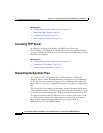
Chapter 2 Preparing to Install the Cisco IP Phone on Your Network
Guidelines for Configuring Ports on the Cisco IP Phone models 7902G/7905G/7912G
2-8
Cisco IP Phone Administration Guide for Cisco CallManager 3.3, Cisco IP Phones 7902G/7905G/7912G
OL-6313-01
Guidelines for Configuring Ports on the
Cisco IP Phone models 7902G/7905G/7912G
Cisco IP Phones include ports for connecting the phones to the network and for
providing power to the phones. These sections provide tips for configuring these
ports:
• Connecting to the Network, page 2-8
• Providing Power to the Cisco IP Phone, page 2-9
Connecting to the Network
The Cisco IP Phone 7912G has two RJ-45 ports labelled “network” and “access.”
The Cisco IP Phone models 7902G/7905G have one RJ-45 port. Each port
supports 10/100 Mbps half- or full-duplex connections to external devices. You
can use either Category 3 or 5 cabling for 10-Mbps connections, but you must use
Category 5 for 100 Mbps connections. On both the network port and access port,
use full-duplex mode to avoid collisions.
See Figure 3-1 for the connection ports available on the back of the Cisco IP
Phone models 7902G/7905G. See Figure 3-2 for the connection ports available on
the back of the Cisco IP Phone 7912G
Related Topics
• Connecting the Cisco IP Phone to the Network, page 3-4
• Using the Network Port, page 2-8
• Using the Access Port, page 2-9
Using the Network Port
Use the network port to connect the phone to the network. You must use a
straight-through cable on this port. The phone can also obtain inline power from
the Cisco Catalyst switch over this connection. See the “Providing Power to the
Cisco IP Phone” section on page 2-9 for details.


















